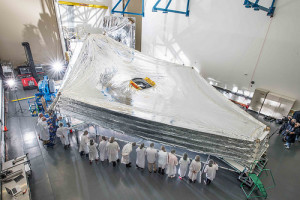With the launch of Hubble’s successor in 2018, the most powerful space telescope ever built will give us new knowledge about the Universe.
It’s called James Webb Space Telescope, or JWST. In order for it to teach us about the universe and our origins, the instruments and infrared cameras of JWST must be protected against infrared radiation from the sun. In order to operate, they need to be cold.
This is where the sunshield comes in.
The sunshield has five layers. Each of the layers is made up of a special material that is highly heat-resistant called Kapton. Each layer will also be coated in aluminum.
The two hottest layers will have an additional coating on their sun-facing side to reflect the sun’s heat. This coating consists of silicon and another material being added to it during the coating process. This is known as doped-silicon and makes the coating electrically conductive.
Four of the layers are only 0.001 inches thick! The first layer isn’t much thicker, being a mere 0.002 inches thick. The aluminum and silicon coatings are even thinner.
The layers will be positioned and separated very accurately, allowing them to block and re-direct heat away from the spacecraft. The layers will be closer to one another in the center and further away at the edges. Additionally, the mirrors and infrared cameras will only directly see the fifth cold layer; the sun will shine on the first layer.
The material is reinforced by strips of a membrane material that are melted together in case a tear or hole forms in the sunshield. This prevents a tear from becoming bigger.
Launching in 2018, JWST will orbit the Sun at a distance from Earth of 1 million miles. Out past the moon, the spacecraft will study the formation of galaxies, stars and planets as well as the evolution of our solar system!
Learn more about JWST at NASA.gov.


